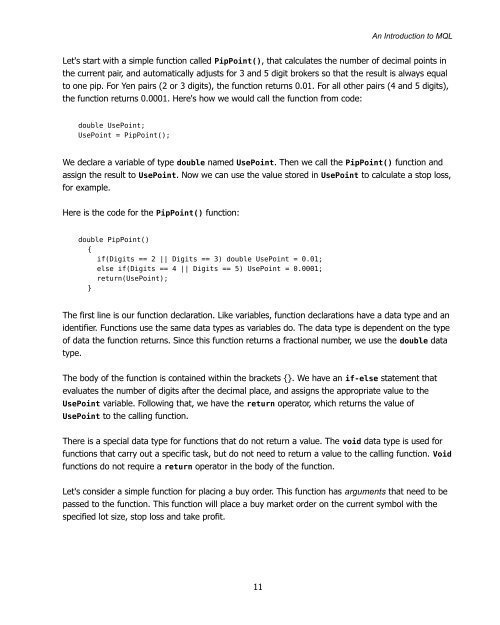Expert Advisor Programming by Andrew R. Young
Expert Advisor Programming by Andrew R. Young
Expert Advisor Programming by Andrew R. Young
Create successful ePaper yourself
Turn your PDF publications into a flip-book with our unique Google optimized e-Paper software.
An Introduction to MQL<br />
Let's start with a simple function called PipPoint(), that calculates the number of decimal points in<br />
the current pair, and automatically adjusts for 3 and 5 digit brokers so that the result is always equal<br />
to one pip. For Yen pairs (2 or 3 digits), the function returns 0.01. For all other pairs (4 and 5 digits),<br />
the function returns 0.0001. Here's how we would call the function from code:<br />
double UsePoint;<br />
UsePoint = PipPoint();<br />
We declare a variable of type double named UsePoint. Then we call the PipPoint() function and<br />
assign the result to UsePoint. Now we can use the value stored in UsePoint to calculate a stop loss,<br />
for example.<br />
Here is the code for the PipPoint() function:<br />
double PipPoint()<br />
{<br />
if(Digits == 2 || Digits == 3) double UsePoint = 0.01;<br />
else if(Digits == 4 || Digits == 5) UsePoint = 0.0001;<br />
return(UsePoint);<br />
}<br />
The first line is our function declaration. Like variables, function declarations have a data type and an<br />
identifier. Functions use the same data types as variables do. The data type is dependent on the type<br />
of data the function returns. Since this function returns a fractional number, we use the double data<br />
type.<br />
The body of the function is contained within the brackets {}. We have an if-else statement that<br />
evaluates the number of digits after the decimal place, and assigns the appropriate value to the<br />
UsePoint variable. Following that, we have the return operator, which returns the value of<br />
UsePoint to the calling function.<br />
There is a special data type for functions that do not return a value. The void data type is used for<br />
functions that carry out a specific task, but do not need to return a value to the calling function. Void<br />
functions do not require a return operator in the body of the function.<br />
Let's consider a simple function for placing a buy order. This function has arguments that need to be<br />
passed to the function. This function will place a buy market order on the current symbol with the<br />
specified lot size, stop loss and take profit.<br />
11
















